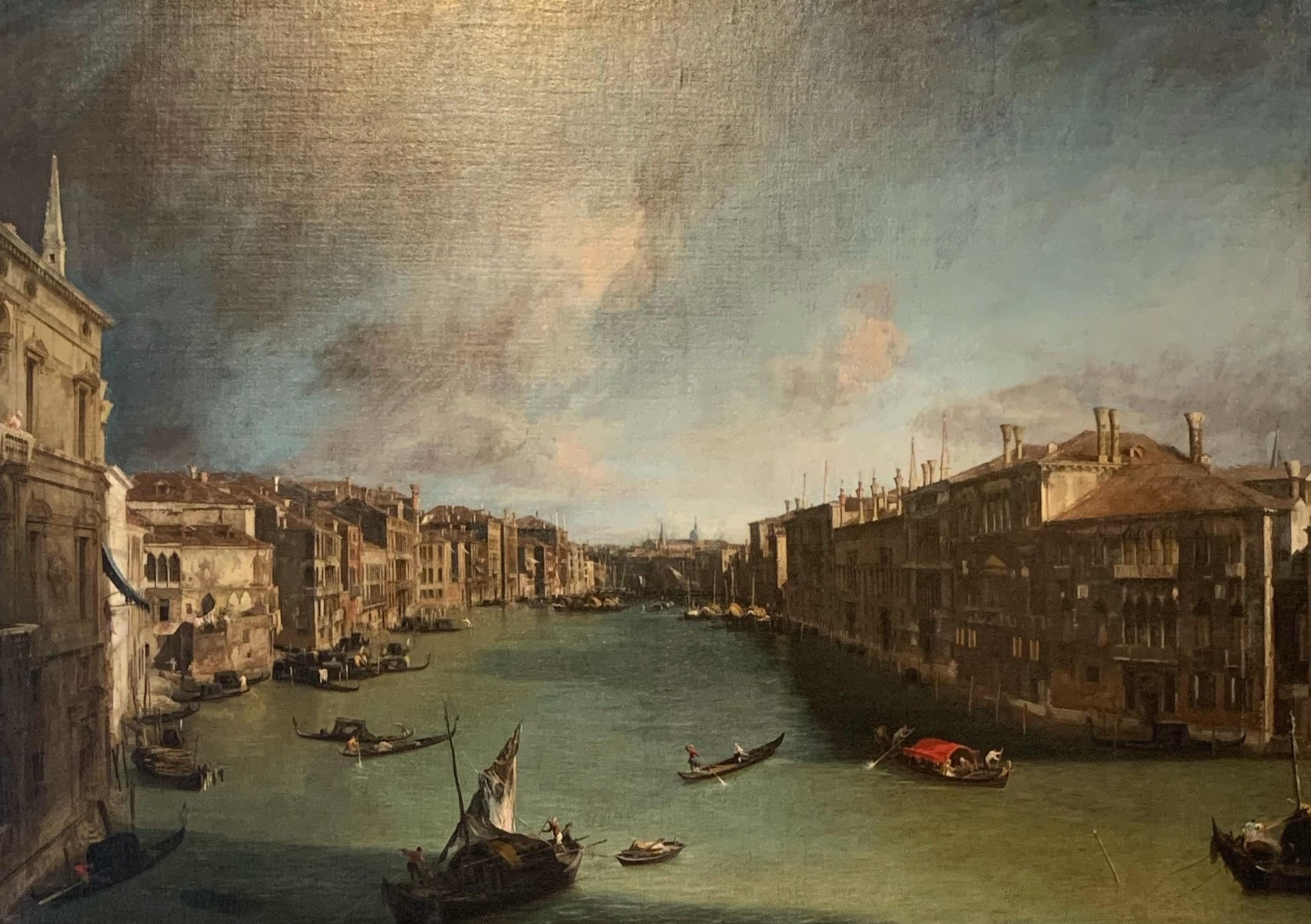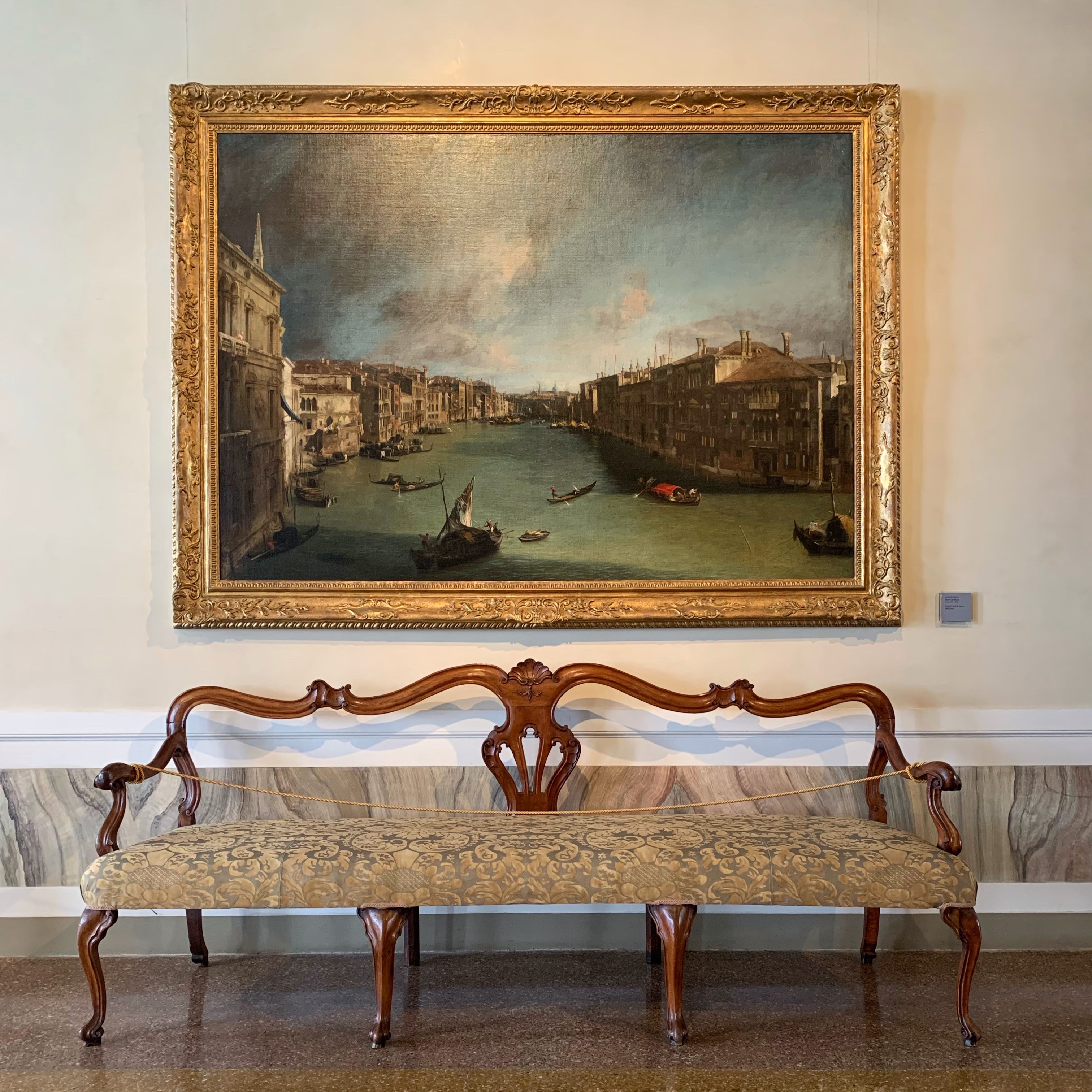
The painting entitled Canal Grande towards Rialto by Canaletto is part of a series of four views made by the Venetian artist in the early 1720s. It is therefore part of Canaletto’s early phase as a painter of views.
The Grand Canal to Canaletto’s Rialto: what to know

The patron of the series of four works, of which Canaletto’s Grand Canal towards Rialto is a part, was only one and scholars have identified him as one of the governors of the Ospedale dei Mendicanti.
Canaletto was famous for his vedute (views) and it is likely that the patron wanted to win works by the greatest artist of the time.
DESCRIPTION OF THE CANAL GRANDE TOWARDS RIALTO BY CANALETTO
Canaletto observes and paints the Grand Canal from Palazzo Balbi in the direction of the Rialto Bridge, which closes the vanishing point, used to construct the entire perspective of the painting, in the background.
The Grand Canal occupies the central part of the painting and along its banks are the palaces, parading side by side.
On the left side the sunlight illuminates the facades, bringing out their details, while on the right side they are mostly in shadow.
Canaletto had begun painting in the wake of his stage designer father and this detail about his life allows us to understand the way he conceived views like this one.
The view of the landscape is theatrical and scenic, the details are precise and even the shadow of Palazzo Balbi on the waters of the Grand Canal is an ante litteram photographic element and extremely spectacular for the time.
The sky is blue but is crossed by a dark, menacing cloud.
A final remark must be made about the gondolas crossing the Grand Canal as they are guided by small figures traced with sommai signs. It almost seems as if Canaletto was only interested in the details of the landscape and that the figures they inhabit are merely accessory elements.
Exploring Canaletto’s meticulous technique is only the beginning of discovering the timeless beauty of Venice. Discover what to see in Venice other than this Canaletto masterpiece and immerse yourself in the enchanting atmosphere of this unique city by visiting the blog pages dedicated to the must-see Venetian attractions!
SOME CURIOSITIES ABOUT THE PAINTING THE CANAL GRANDE VERSO RIALTO BY CANALETTO
Canaletto’s painting of the Grand Canal towards Rialto, together with the entire series created by the artist, was sold to the Prince of Liechtenstein and arrived in Vienna at the end of the 18th century. This single canvas was then transferred to a private collection, until it was purchased by the Musei Civici di Venezia and included in the exhibition itinerary to be seen at Ca’ Rezzonico, where it is now exhibited.
CANALETTO’S METICULOUS TECHNIQUE: CAPTURING THE BEAUTY OF VENICE WITH PRECISION AND SKILL
Canaletto is famous for his detailed and realistic views of Venice. His working technique was admired and studied by artists and enthusiasts all over the world also because he used a combination of field sketches and photographic references due to the use of the Camera Ottica, also used by Vermeer, among others, which allowed him to accurately capture every architectural and landscape detail.
His mastery of perspective was exceptional, infusing his works with a feeling of extraordinary depth and realism. To achieve this, Canaletto used a special grid to draw guidelines and accurately position elements in the composition.
His painting technique was equally remarkable and we can state that Canaletto painted with a unique technique. He used fine brushes to create minute details, especially in architecture and reflections on water. His colours were vivid and saturated, capturing the unique atmosphere and light of Venice.
Canaletto devoted enormous attention to detail, often spending hours painting small elements and architectural features. This contributed to the richness and vividness of his works.
Ultimately, Canaletto’s working technique was a perfect balance of precision, careful observation and painterly skill. His detailed and realistic approach made his views of Venice extraordinary works of art that continue to enchant and inspire art lovers to this day.

